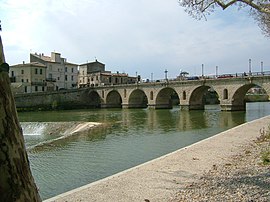Sommières
| Sommières, France | ||
|---|---|---|

Vidourle and the Roman Bridge
|
||
|
||
| Coordinates: 43°47′07″N 4°05′27″E / 43.7853°N 4.0908°ECoordinates: 43°47′07″N 4°05′27″E / 43.7853°N 4.0908°E | ||
| Country | France | |
| Region | Occitanie | |
| Department | Gard | |
| Arrondissement | Nîmes | |
| Canton | Sommières | |
| Intercommunality | Pays de Sommières | |
| Government | ||
| • Mayor (2008–2014) | Guy Marotte | |
| Area1 | 10.36 km2 (4.00 sq mi) | |
| Population (2008)2 | 4,510 | |
| • Density | 440/km2 (1,100/sq mi) | |
| Time zone | CET (UTC+1) | |
| • Summer (DST) | CEST (UTC+2) | |
| INSEE/Postal code | 30321 /30250 | |
| Elevation | 19–106 m (62–348 ft) (avg. 34 m or 112 ft) |
|
|
1 French Land Register data, which excludes lakes, ponds, glaciers > 1 km² (0.386 sq mi or 247 acres) and river estuaries. 2Population without double counting: residents of multiple communes (e.g., students and military personnel) only counted once. |
||
1 French Land Register data, which excludes lakes, ponds, glaciers > 1 km² (0.386 sq mi or 247 acres) and river estuaries.
Sommières is a commune in the Gard department in southern France.
It lies 22 km (14 mi) from Nîmes, 28 km (17 mi) from Montpellier.
Sommières is to the south of the garrigues and on the edge of the Vaunage, a wine growing region. It straddles the River Vidourle.
The village first settled on the arcades of the Roman bridge on the Vidourle river, built by Roman Emperor Tiberius during the Ist century.
The village grew in the protection of the castle. It was annexed into the French kingdom by King Louis IX in 1248, following the crusade against the Albigensiens. It became a Protestant stronghold, and it was besieged by the Catholics in 1573 and again by Louis XIII in 1622.
The Fourth War of Religion (1562–98) started with the St Bartholomew's Day massacre and finished with the Edict of Nantes. The catholic forces were trying to suppress the Huguenots in this one of their strongholds. Marshall Damville laid siege to Sommières for the second time on 11 February 1573, and the garrison held out 9 April, resisting the attackers with red hot iron and boiling oil. Though nominally a royal victory, the defenders were offered generous terms, including the right for the garrison to march out with full honours of war. The Siege of Sommières delayed the advance of the royal army by two months and is calculated to have cost them 2500 lives. Only 38 houses remained standing
...
Wikipedia



